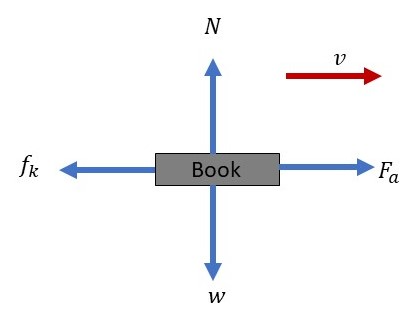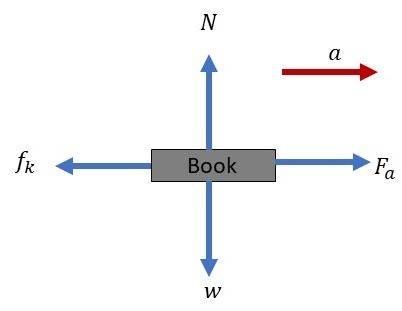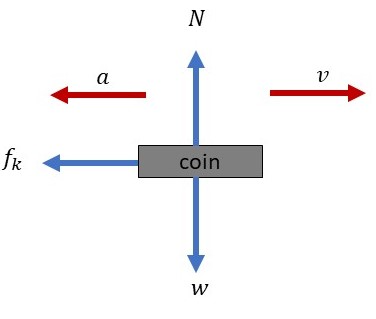
All Solutions
Page 176: Lesson Check
Kinetic frictional force is directly proportional to the normal force acting on the body in contact, which as explained before has increased, and so the kinetic friction also increases in the same proportion.
Because if he locks the brakes and skid, in this case, the tire is subjected to kinetic friction.
But if he didn’t lock the brakes allowing the tires to roll rather than skidding, the rolling tires are subjected to static friction.
And we know that the static friction is larger than the kinetic friction, $mu_s > mu_k$.
Therefore, locking the brakes is not the shortest way to stop.
Friction is undesirable if the energy of the kinetic object must be maintained. A few examples would be sliding an object down a slope, and pushing heavy objects.
Friction is desirable for situations that involve rotations and stopping a certain motion. Such examples can be hitting the brakes of a vehicle and rolling a ball without slipping.
The kinetic friction on an object is proportional to the normal force on the object:
$$
begin{gather*}
f_k = mu_k Ntag{1}
end{gather*}
$$
Where $mu_k$ is the coefficient of kinetic friction.
The mass of the book is $m = 0.270$ kg and the coefficient of kinetic friction between the book and the table is $mu_k = 0.110$.
Since the book is moving with constants speed, there is no acceleration in both the vertical and the horizontal directions.
In the vertical direction, there are two forces acting on the book, one is its weight directed downward and the other is the normal force exerted by the table directed upward.
By applying $textbf{Newton’s first law}$ to the book in the $y$ direction, we get:
$$
begin{align*}
sum F_y = N – w & = 0\\
N &= w = mg
end{align*}
$$
Now, we plug our value for $m$, so we get the normal force on the book:
$$
begin{gather*}
N = (0.270text{ kg}) cdot (9.81text{ m/s}^2) = 2.65text{ N}
end{gather*}
$$
Now, we plug our values for $N$ and $mu_k$ into equation (1), so we get the kinetic friction on the book:
$$
begin{gather*}
f_k = (0.110) cdot (2.65text{ N}) = 0.291text{ N}
end{gather*}
$$

So, w eapply $textbf{Newton’s first law}$ to the book in the $x$ direction, so we get:
$$
begin{align*}
sum F_x = F_a – f_k &= 0\\
F_a & = f_k = 0.291text{ N}
end{align*}
$$
$$
therefore quad large boxed{F_a = 0.291text{ N}}
$$
Thus, the required applied force to keep the book moving with constant speed is $0.291$ N.
If we get the summation of forces along the y direction (vertical direction), we get
$$
Sigma F_{y} = N – W = 0 , where space W = mg
$$
$$
N = W = mg
$$
$$
N = (0.27kg)(9.81m/s^2) = 2.65N
$$
$$
f_{k} = mu _{k} N = (0.11)(2.65N)
$$
$$
f_{k} = 0.29N
$$
$$
Sigma F_{x} = F- f_{k} = 0
$$
$$
F = f_{k}
$$
$$
F = 0.29N
$$
F = 0.29N
$$
The kinetic friction on an object is proportional to the normal force on the object:
$$
begin{gather*}
f_k = mu_k Ntag{1}
end{gather*}
$$
Where $mu_k$ is the coefficient of kinetic friction.
From $textbf{Newton’s second law}$ for multiple forces, the net force on an object is equal to its mass times its acceleration:
$$
begin{gather*}
sum vec{textbf{F}} = mvec{textbf{a}}tag{2}
end{gather*}
$$
The mass of the book is $m = 0.390$ kg, its acceleration is $a_x = 0.180text{ m/s}^2$ and the coefficient of kinetic friction between the book and the table is $mu_k = 0.210$.
In the vertical direction, there are two forces acting on the book, one is its weight directed downward and the other is the normal force exerted by the table directed upward.
Sicne there is no acceleration in the vertical direction, we apply $textbf{Newton’s first law}$ to the book in the $y$ direction, we get:
$$
begin{align*}
sum F_y = N – w & = 0\\
N &= w = mg
end{align*}
$$
Now, we plug our value for $m$, so we get the normal force on the book:
$$
begin{gather*}
N = (0.390text{ kg}) cdot (9.81text{ m/s}^2) = 3.83text{ N}
end{gather*}
$$
Now, we plug our values for $N$ and $mu_k$ into equation (1), so we get the kinetic friction on the book:
$$
begin{gather*}
f_k = (0.210) cdot (3.83text{ N}) = 0.803text{ N}
end{gather*}
$$

Since the book is moving with a nonzero acceleration in the horizontal direction, we apply $textbf{Newton’s second law}$ to the book in the $x$ direction, so we get:
$$
begin{align*}
sum F_x = F_a – f_k & = ma\\
F_a & = f_k + ma
end{align*}
$$
Now, we plug our values for $f_k$, $m$ and $a$, so we get the required force:
$$
begin{gather*}
F_a = 0.803text{ N} + (0.390text{ kg}) cdot (0.180text{ m/s}^2) = 0.874text{ N}\\
therefore quad large boxed{F_a = 0.874text{ N}}
end{gather*}
$$
The maximum static friction on an object is proportional to the normal force on the object:
$$
begin{gather*}
f_{s,max} = mu_s Ntag{1}
end{gather*}
$$
Where $mu_s$ is the coefficient of static friction.
The mass of the flowerpot is $m = 14.0$ kg and the coefficient of static friction between the pot and the surface on which it rests is $mu_s = 0.64$.
Since the flowerpot is at rest, there is no acceleration in any direction.
In the vertical direction, there are two forces acting on the pot, one is its weight directed downward and the other is the normal force exerted by the surface directed upward.
So, we apply $textbf{Newton’s first law}$ to the pot in the $y$ direction, so we get:
$$
begin{align*}
sum F_y = N – w &= 0\\
N & = w = mg
end{align*}
$$
Now, we plug our value for $m$, so we get the normal force on the pot:
$$
begin{gather*}
N = (14.0text{ kg}) cdot (9.81text{ m/s}^2) = 137text{ N}
end{gather*}
$$
Now, we plug our values for $N$ and $mu_s$ into equation (1) so we get the maximum static friction on the pot:
$$
begin{gather*}
f_{s,max} = (0.640) cdot (137text{ N}) = 87.9text{ N}
end{gather*}
$$

At the moment when the pot is about to move, the static friction is maximum.
So, we apply $textbf{Newton’s first law}$ to the pot in the $x$ direction at this moment, so we get:
$$
begin{align*}
sum F_x = F_a – f_{s,max} &= 0\\
F_a & = f_{s,max}
end{align*}
$$
Thus, the required force to set the pot in motion is:
$$
begin{gather*}
large boxed{F_a = 87.9text{ N}}
end{gather*}
$$
The kinetic friction on an object is proportional to the normal force on the object:
$$
begin{gather*}
f_k = mu_k Ntag{1}
end{gather*}
$$
Where $mu_k$ is the coefficient of kinetic friction.
From $textbf{Newton’s second law}$ for multiple forces, the net force on an object is equal to its mass times its acceleration:
$$
begin{gather*}
sum vec{textbf{F}} = mvec{textbf{a}}tag{2}
end{gather*}
$$
From velocity-position equation, for an object moving with constant acceleration, the final speed, the initial speed, the acceleration and the change in position are related by:
$$
begin{gather*}
v_f^2 = v_i^2 + 2aDelta xtag{3}
end{gather*}
$$
The mass of the coin is $m = 0.011$ kg, its initial speed is $v_i = 1.80$ m/s and the distance it slides before it comes to rest is $x = 0.86$ m.
(a) Since the coin eventually comes to rest, $v_f = 0$, we plug our values for $v_i$, $v_f$ and $Delta x$ into equation (3) and solve for $a$, so we get the acceleration of the coin:
$$
begin{align*}
(0)^2 &= (1.80text{ m/s})^2 + 2 (0.860text{ m}) a\\
a & = dfrac{- (1.80text{ m/s})^2}{2 (0.860text{ m})} = -1.88text{ m/s}^2
end{align*}
$$
Sicne there is no acceleration in the vertical direction, we apply $textbf{Newton’s first law}$ to the coin in the $y$ direction, we get:
$$
begin{align*}
sum F_y = N – w & = 0\\
N &= w = mg
end{align*}
$$
Now, we plug our value for $m$, so we get the normal force on the coin:
$$
begin{gather*}
N = (0.011text{ kg}) cdot (9.81text{ m/s}^2) = 0.108text{ N}
end{gather*}
$$

Since the coin is moving with a nonzero acceleration in the horizontal direction, we apply $textbf{Newton’s second law}$ to the coin in the $x$ direction, so we get:
$$
begin{align*}
sum F_x = – f_k & = ma\\
f_k & = -ma
end{align*}
$$
Now, we plug our values for $m$ and $a$, so we get the kinetic friction on the coin:
$$
begin{gather*}
f_k = – (0.011text{ kg})cdot (-1.88text{ m/s}^2) = 0.021text{ N}
end{gather*}
$$
Finally, we plug our values for $f_k$ and $N$ into equation (1) and evaluate for $mu_k$, so we get the coefficient of the kinetic friction between the coin and the table:
$$
begin{gather*}
mu_k = dfrac{f_k}{N} = dfrac{0.021text{ N}}{0.108text{ N}} = 0.192\\
therefore quad large boxed{mu_k = 0.192}
end{gather*}
$$
$$
begin{gather*}
N = Mg
end{gather*}
$$
Substituting into equation (1), we get the kinetic friction:
$$
begin{gather*}
f_k = mu_k (Mg) = Mmu_k g
end{gather*}
$$
Then, we apply $textbf{Newton’s second law}$ to the coins in the $x$ direction, so we get:
$$
begin{align*}
-f_k &= Ma\\
-Mmu_k g & = Ma\\
a & = -mu_k g
end{align*}
$$
We see that the acceleration of coins does not depend on the mass.
Since the coins have the same acceleration and the same initial speed as the one coin, they will slide $textbf{the same distance}$ before coming to rest.
(b) $textbf{The same distance.}$ Because the acceleration does not depend on the mass.

